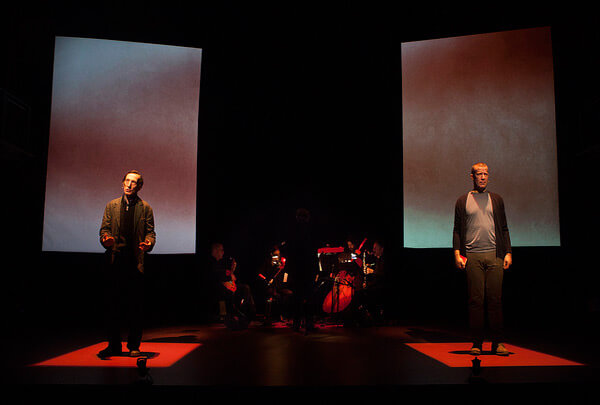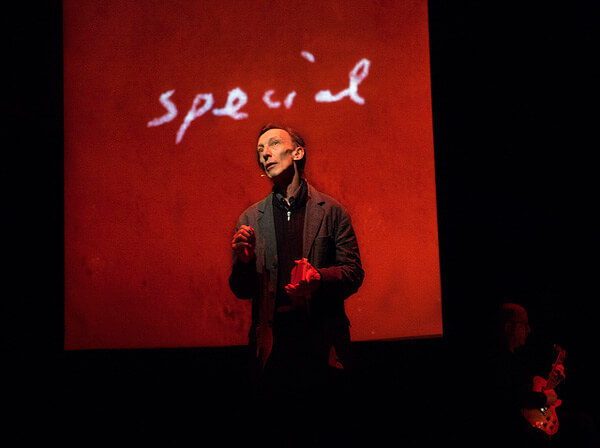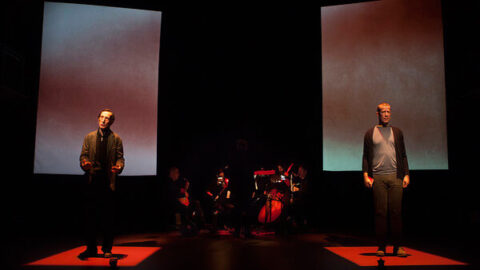 Wednesday, April 9, 2014, marked the first return of Art of Time Ensemble’s entrancing I Send You This Cadmium Red to Toronto since its initial debut in 2011. The production, directed by Daniel Brooks alongside musical director Andrew Burashko at Enwave Theatre in Harbourfront Centre, is based on a series of letters exchanged over the course of two years (1997 to 1999) between poet/art critic John Berger and painter/filmmaker John Christie. Having since become a book as well as a radio play, Cadmium Red is by nature a project of chameleonic charm. Art of Time Ensemble’s rendering of the project takes this into consideration and, in turn, truly brings it to life on stage.
Wednesday, April 9, 2014, marked the first return of Art of Time Ensemble’s entrancing I Send You This Cadmium Red to Toronto since its initial debut in 2011. The production, directed by Daniel Brooks alongside musical director Andrew Burashko at Enwave Theatre in Harbourfront Centre, is based on a series of letters exchanged over the course of two years (1997 to 1999) between poet/art critic John Berger and painter/filmmaker John Christie. Having since become a book as well as a radio play, Cadmium Red is by nature a project of chameleonic charm. Art of Time Ensemble’s rendering of the project takes this into consideration and, in turn, truly brings it to life on stage.

I Send You This Cadmium Red first premiered three years ago to much critical acclaim, and it’s easy to see why. Every aspect of the show is gracefully executed and with great sensitivity to its epistolary origins. The production, best described as a series of meditations on colour and music, has since been tweaked and refined in little ways — for instance, Gavin Bryars composed an additional prologue and epilogue to bookend the performance — but the soul of it was kept very much intact. Actors Julian Richings and John Fitzgerald Jay narrated the letter correspondence throughout the 60-minute performance, and were accompanied by Bryars’ original compositions (performed by Carolyn Blackwell, Robert Carli, Joseph Phillips, and Rob Piltch of the Art of Time Ensemble) alongside entrancing visual projections by Bruce Alcock.
The musical component of Cadmium Red served to underscore and capture the essence of each colour mentioned in the letters. To this effect, the music did not and did not need to stand out. Instead, it heightened the audience’s awareness of their own senses, and helped to convey moods and feelings that could not be represented visually or linguistically. Bryars’ music was thus patient and inviting, even when the colours themselves were not of such nature. His choice of instrumentation (viola, electric guitar, double bass, and bass clarinet) was a clever reflection of this introspective attitude and, as a result, drew the audience deep into the heart of Berger and Christie’s often philosophical musings by way of a rich, warm tonal palette.

The way that Cadmium Red was staged — musicians in the middle, flanked by the projections and actors on either side — also gave the music an added meaning: to connect the two correspondents across time. Between the reading of each letter, there was a often a lengthy pause in which the ensemble’s continuous playing would act as a segue of sorts. One could interpret it as the intimate human connection, the bond between two friends (otherwise invisible and foreign to everyone else), illuminated by way of sound. Paired with the expert articulations of Richings and Fitzgerald Jay, Bryars’ unassumingly emotive music was much like poetry put in motion.
Though difficult to define, I Send You This Cadmium Red felt wonderfully integrated, and above all, soulful. It is not just a patchwork of music and words and visuals thrown onto a stage, but the essence of it all, distilled; one cannot help but wonder why productions of this sort are not more common. After all, “colour, and our need for colour, is everywhere.”
























